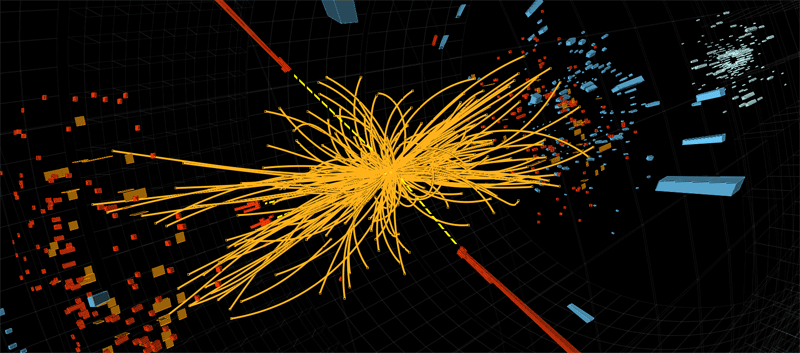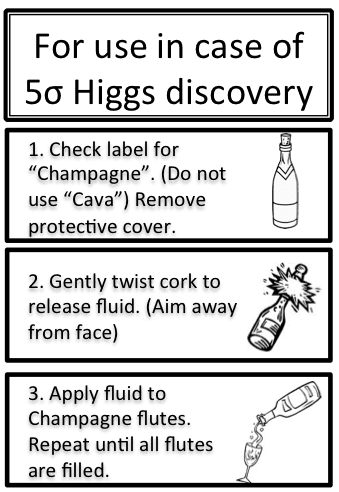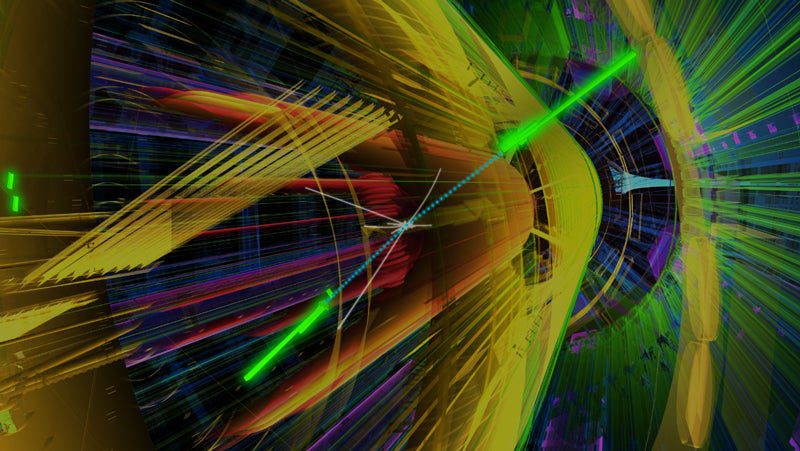“We have discovered a new particle,” CERN director general Rolf Heuer said Wednesday morning. “A boson. Most probably a Higgs boson.” Even the most anticipated news in science does not come without some caveats.
Still, all signs point to a discovery today, arguably one of the most important findings in modern physics. The inscrutable Higgs boson, carrier of mass and final puzzle piece of physics’ prevailing theory, may have finally been found. Now comes the fun part — depending on what it looks like, this saga may be just beginning. [UPDATED]
Two experiments at Europe’s Large Hadron Collider, built to study the fundamental particles and forces underlying physical reality, separately found evidence for the new particle. Both the ATLAS and CMS experiments reported a 5-sigma statistical confidence level — essentially a 100 percent certainty that a new particle exists. We first saw tantalizing signs of this last fall, but since then the LHC has collided many more particles to see what comes out. Wednesday’s news is the result of 2011 and 2012 data, although the 2012 data is still being crunched.
The Higgs boson weighs what theoretical predictions say it should, according to both ATLAS and CMS. It’s about 125-126 gigaelectronvolts, or about 130 times heavier than a proton. The LHC was able to find it by speeding protons at incredibly high energies through its vast series of tubes, and smashing them together. Mass and energy are the same thing, so when the protons have very high energies, they’re very large. They blow apart when they collide, and physicists look for smaller constituent particles in the shrapnel. That’s where they see the Higgs boson.
“This is indeed a new particle. We know it must be a boson, and it’s the heaviest boson ever found,” said CMS spokesperson Joe Incandela. Lots of work is still needed to verify that it is the storied Higgs, however. Despite the cautious statements, the news was clearly cause for celebration at CERN and at physics laboratories in the US. “As a layman, I would say I think we have it,” Heuer told the crowd Wednesday morning. “Would you agree?” A roar of applause went up in response.

Higgs Candidate Event
Without the Higgs boson, physicists have no way to explain how the universe — stars, galaxies, us — can exist. The boson is a particle, like a quark or an electron, but this is really a component of a force field known as the Higgs field. It’s like a universal stickiness that all things feel. A photon is a good analogy, says Paul Padley, a particle physicist at Rice University. It’s a light particle, but it also carries the electromagnetic force. The Higgs boson is a similar force carrier. According to theory, every other particle, every little quark and lepton, interacts with this sticky field; this interaction gives them their mass. Mass allows the particles to interact with each other, combining into atoms and molecules and stars and us.
“The reason why we care about it is if the Higgs boson doesn’t exist, then we have absolutely no physical understanding of why we exist,” Padley said. “You can’t explain the universe.”
Scottish physicist Peter Higgs, now 83, theorized the eponymous particle decades ago, to explain this mass confusion. He sat in the front row for CERN’s symposium Wednesday, and his eyes welled with tears, according to Reuters: “It is an incredible thing that it has happened in my lifetime,” he told his fellow scientists.
Two separate verifications at five sigma is a stronger signal than some physicists were expecting. Last year, the ATLAS team saw signs of a Higgs particle weighing 125 to 126 GeV, at a confidence level of 3.6σ. The CMS team saw potential around 124 GeV, with a confidence level of 2.6σ.
Using two different experiments is a way to verify the results, said Dan Green, a physicist at Fermilab and a member of the CMS team. The ATLAS and CMS detectors use different cooling mechanisms and detection methods to study particles, so each detector has different errors. If they both see something, that dramatically decreases the likelihood that it’s a fluke.
The ATLAS and CMS teams each kept their results confidential until Wednesday, reducing the potential for cross-contamination or unintentional bias. Physicists involved in both collaborations said this made for some awkward conversations.

For Use In Case Of Higgs
“It’s very weird. I was at CERN last week, sitting and having lunch with friends I have on the ATLAS experiment, and we would not talk about the hunt for the Higgs boson, so we don’t poison our minds,” Padley said. “Instead, you talk about how great the accelerator is performing, or speculate about what dark matter is. You solve the world’s economic problems, maybe. You just move to other things.”
Now that it’s been found — ahem, probably, very likely, seems to have been found — there’s still a lot to be done. As Heuer said, now physicists have to find out which kind of Higgs boson this is. Does it behave according to the Standard Model of particles and forces, or not? What are its properties? These questions may in some ways be even more interesting. “It’s the beginning of a long journey to investigate all the properties of this interesting particle,” Heuer said.
Padley compared the next steps to a crime scene. Imagine someone goes missing, and a massive search begins. A few months later, a body is found in a lake, and it fits the description of the missing person.
“At that point, the police are going to be very careful. They’re going to say, ‘Before we decide who this is, we’re going to do DNA testing,'” he said. “So once a particle is found that is consistent with being the Higgs, there is still a lot of work to be done, studying it and making sure it is in fact the Higgs boson we know and love from our theory.”
There are plenty of theoretical questions to address. The Higgs may have four cousin particles, said Tom LeCompte, a physicist at Argonne National Laboratory and a member of the ATLAS team. On a scale of “Higgsiness,” this particle may be 100 percent Higgsy, or it may be less, he said. Physicists need to figure out whether it does everything it’s supposed to, or if there really are four versions. Maybe there are versions with an electrical charge, or versions that weigh more or less. Maybe it is a scalar particle — a very weird thing indeed, with no charge or spin. It would be the first scalar fundamental particle.
“This is why everybody is not only excited about the discovery, but everybody is excited about the prospect this discovery opens for physics,” Heuer said.
So, stay tuned for a summer of more interesting results.









